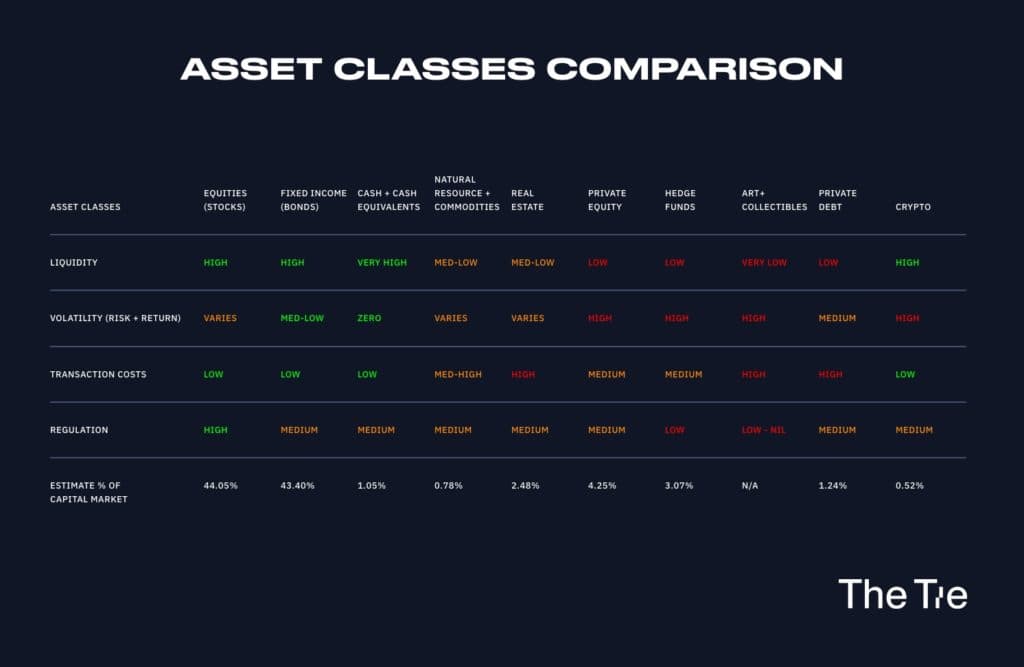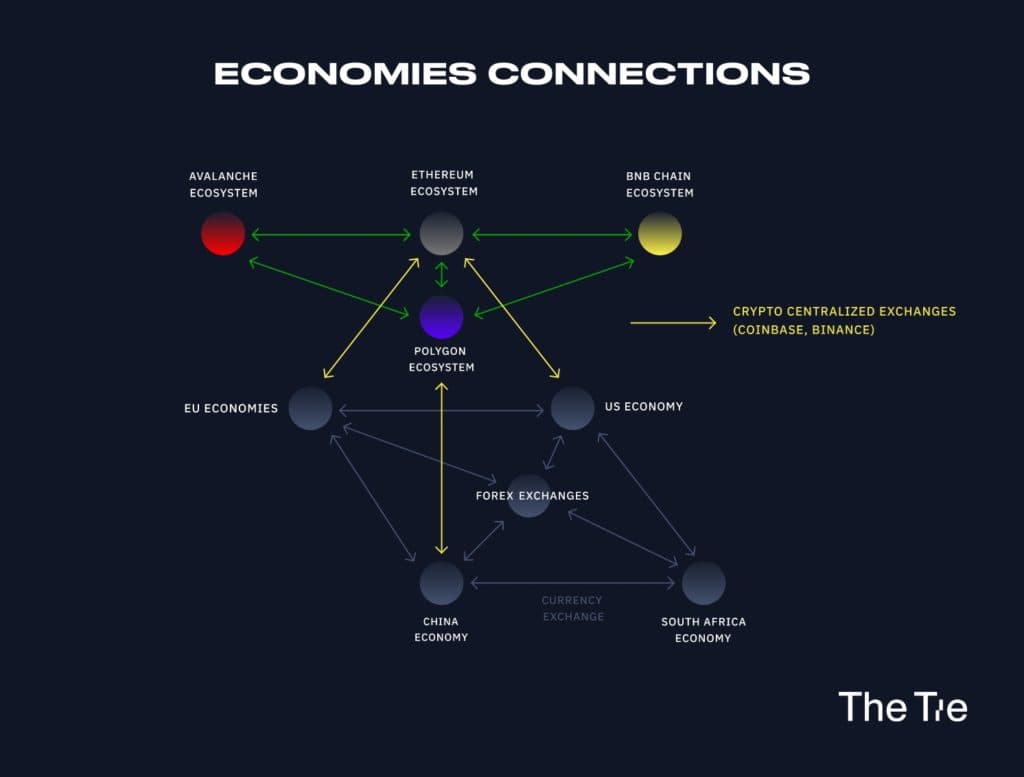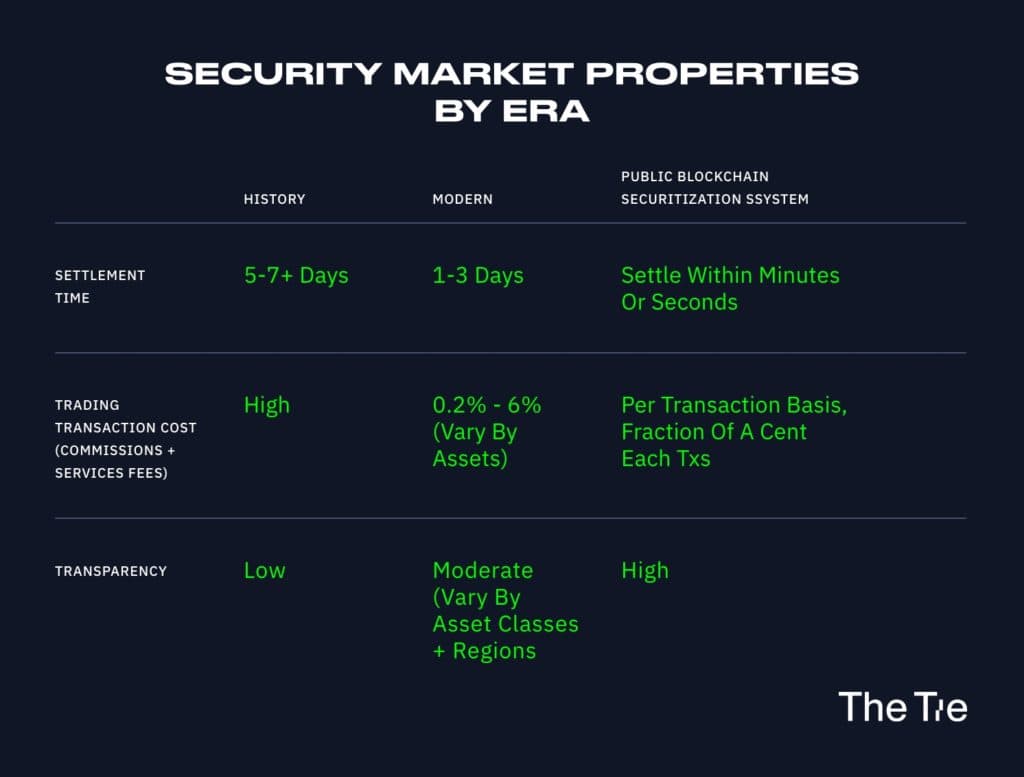Securitization brought about the centralization of equity and fixed-income assets. Real-world asset tokenization emerged as a hot topic amid the crypto bear market in 2022, an approach poised to leverage public blockchain technology to unlock growth in capital market share for alternative assets.
The Tie Research
Tokenizing & Securitizing Real World Assets on Public Blockchains
Public blockchains and tokenized securities can be the next technological step for enabling deeper liquidity and reducing transaction costs, hence increasing capital efficiency and on-boarding new sets of investors around the globe.
The birth and success of securitization
The modern concepts of equity and debt, which refer to claims on cash flow or cash payments from a company, can be traced back to the development of modern corporations in the 17th and 18th centuries. Before securities were invented, there were 2 effective means of raising capital for business purposes:
- Borrow money from acquaintances (debt)
- Form business partner or investor relationships with acquaintances (equity)
However, these informal and unstandardized practices created major social and geographic access barriers for investors and business owners. Then, the mechanics and infrastructure of securitization came into play, bringing capital markets to a new level of efficiency.
Securities – either equity or debt instruments – pool assets and package them into ownable products. Securities are often standardized and available within highly regulated secondary markets to improve liquidity and lower transaction costs.
Over time, standardized securities have become an essential part of the modern financial system, taking up more than 80% of the capital market, significantly outweighing alternative asset classes such as real estate, private equity, and commodities.

Source: CAIA
Standardized securities and technological advancements in trading infrastructure have contributed significantly to the success of equity and fixed-income markets. However, other asset classes can follow and grow their capital market share if technological innovations can either (1) significantly increase their liquidity or (2) reduce the transaction cost of buying and selling them.
Liquidity
By definition, liquidity is the efficiency or the ease of converting assets without affecting their market price. Let's break down the factors that can affect the liquidity of asset classes, including transparency, investor confidence, accessibility, and infrastructure. We’ll link these factors to concrete potential benefits enabled by blockchain technology.
Transparency & Investor Confidence
Transparency tends to create more confidence for investors, leading to more people parking their savings and wealth into transparent asset classes. Moreover, a high level of investor confidence also helps stabilize capital markets by reducing volatility. The popularity of US Equity and fixed-income markets relative to other geographic markets comes as no surprise, given that regulators have successfully created frameworks and requirements to enhance market integrity and transparency relative to other foreign capital markets.
The public ledger at the core of public blockchain technology yields an opportunity for a market with even more transparency. All transactions and smart contract settlement could be displayed on the public ledger, ready for near real-time auditing if necessary.
Accessibility- Barriers to Participate
Modern brokers have enhanced the divisibility of asset classes. Brokers such as Robinhood now allow small investors to purchase decimal units of shares. This feature helps reduce or remove barriers to entry for small investors.

However, international legal compliance challenges create barriers between different capital markets, which can reduce market efficiency by artificially gating the flow of foreign capital into diverse sets of asset classes. Thus, the borderless aspect of public blockchains offers an advantage to new asset classes in competing with well-developed asset classes, such as US equity and fixed income instruments.
Infrastructure
Trading infrastructure has effects on two components of liquidity: trading volume (total trading volume is capped by what the marketplace technology can handle) and transaction costs. Infrastructure includes both the underlying technology that supports the system and the efficiency of the associated legal process.
Different marketplace systems facilitate transactions per asset class, each with different regulatory restrictions. Most of economic activity, including trading, happens on the top of the Automation Clearing House (ACH) system. The clearing house acts as the middleman, mitigating counterparty risk by guaranteeing that the seller delivers the security to the buyer and the buyer pays the seller the agreed-upon price. Here the clearing house plays the role of helping maintain the integrity and stability of the stock exchange.
The underlying ACH system is limited to settling transactions after 1 – 3 business days, and requires day-to-day upkeep to operate. On the other hand, public blockchain technology executes this process within minutes, uses smart contracts to guarantee agreed-upon terms, and executes the matched orders transparently and in real-time. Blockchain infrastructure potentially offers the ability to remove human capital required to facilitate trading, while simultaneously enabling a less regulated but more transparent process.
For example, suppose two parties decide to exchange securitized Private Equity ownership on the public blockchain market with the determined price of 1000 USDC per share. A transparent ledger, like a public blockchain, allows both parties (and/or the smart contract) to verify whether: (1) party A has 1 share of the securitized PE share, and (2) party B has 1000 USDC in their wallet. This can help remove the need for clearing houses from the trading process, which reduces both transaction costs and time of settlement compared to the traditional process.
Transaction Costs
While there is room for further improvement, our current system has significantly reduced the transaction cost of trading securities.

A study by Dominique Y Dupont - Board of Governors of the Federal Reserve System - has shown that lower transaction costs can significantly increase market depth and liquidity if market conditions are favorable to the dealer and asset values are normally distributed.
The transaction costs for standardized securities, such as listed equity and fixed income, have declined significantly, even falling to 0% commission for retail access through broker-dealers like Robinhood.
On the other hand, transaction costs for asset classes like real estate and private equity are significantly higher. Real estate commission rates remain between 5% to 6%, with a national average of 5.7% in 2022, according to the National Association of Realtors. There are also legal fees and broker commissions when selling private equity shares, which can be considered transaction costs.
At the root, the transaction cost of exchanging assets is driven by frictions of the infrastructure, such as operating expenses and middleman commissions, which sometimes are caused by complex regulations and legal requirements. The more challenging it is to facilitate transacting, the more expensive the transaction cost of exchanging those asset classes becomes.
Reducing transaction costs also increases investor ROI, creating liquidity provision incentives across asset classes. Is decentralized securitization the proper approach?
Tokenization
Reducing reliance on middlemen creates more streamlined and cost-optimized trading processes for capital markets. While there are different technological approaches, securitization using public blockchains has a distinct set of advantages and challenges.
Tokenized assets with a robust global payment railroad
While public blockchains are still finding the best scaling solutions for their infrastructure, settlement times and costs per transaction are already lower than ACH, and significantly below exorbitant fees around international transfers.
The peer-to-peer system of public blockchains supports settlement within minutes, or even within a few seconds. The cost to transact on public blockchains can vary between a few dollars (Ethereum) to less than a fraction of a cent (Avalanche, Polygon, BNB Chain, or other Ethereum Layer 2s). Due to this, tokenizing and digitally securitizing real-world assets can potentially result in dramatic capital access improvements for asset classes such as commodities, real estate, private equity, and hedge funds.
Increasing liquidity can positively impact transaction costs since it can reduce bid-ask spreads. Lower transaction costs also translate to higher ROIs for investors, and therefore create liquidity provision incentives across asset classes.This also opens a new door for companies and businesses to receive more diverse funding.
Bringing a new set of underlying digital assets to DeFi
Real-world assets are protected by centralized authorities within the framework of a complex legal system. Therefore, tokenized securities from centralized issuers can leverage both (1) traditional legal protections and (2) the technological advancements and infrastructures of public blockchains, creating a new set of digital assets on public blockchains tied to a robust set of valuable underlying real-world assets.
The early adopters of tokenized securities
KKR, one of the world's most reputable private investment funds - is accessible only to institutional investors and accredited investors within the private market. However, Securitize Investment Arm recently launched tokenized exposure to KKR's Health Care Strategic Growth Fund II on the public blockchain Avalanche. Therefore, Securitize's users can now gain portfolio exposure in KKR’s Health Care Strategic Growth Fund II (HCSG II) entirely on-chain. This reflects the effort of the Securitize team to make institutional private market strategies more accessible to individual investors and explore the benefit of tokenizing alternative assets on the public blockchain.
Similarly, Hamilton Lane, one of the largest private market investment firms globally, adopted the idea of tokenizing private assets and partnered with the Securitize team. Hamilton Lane committed to launching new tokenized funds to help introduce three special funds to a new set of investors, improve liquidity and transparency and reduce the transaction cost through public blockchain technology.
Although Ethereum's DeFi infrastructure is more developed and has greater liquidity, transaction costs on Ethereum Mainnet (layer 1) remain significantly higher than alternatives. These fees, along with subnet support for customizable VMs and support for tailored regulations on each, motivated the Securitize team to choose Avalanche over Ethereum.
Conclusion
Although public blockchain infrastructures are still nascent, they are showing the potential to both (1) significantly increase the liquidity of asset classes and (2) reduce the transaction costs for trading alternative assets while allowing more investors to participate on a global scale.
However, evolving compliance and regulatory requirements for digital assets might challenge the process of tokenizing different asset classes in an effort to help them compete with the success of equity and fixed-income markets.
Early adopters like Hamilton Lane and Securitize Capital (Securitize’s Investment Arm) with tokenized exposure to KKR's HCSG II on Avalanche have showcased a tremendous interest in utilizing blockchain technology around the globe to enhance the efficiency of the financial market.

Effective use of blockchain technology promises lower transaction costs, enhanced liquidity, and increased transparency for more streamlined legal compliance through a fast peer-to-peer payment railroad. If these components can pull together, we can expect to see the impact of blockchain technology on the structure of capital markets in the next few years, especially with the support of global authorities and regulators.
This report is for informational purposes only and is not investment or trading advice. The views and opinions expressed in this report are exclusively those of the author, and do not necessarily reflect the views or positions of The TIE Inc. The Author may be holding the cryptocurrencies or using the strategies mentioned in this report. You are fully responsible for any decisions you make; the TIE Inc. is not liable for any loss or damage caused by reliance on information provided. For investment advice, please consult a registered investment advisor.
Sign up to receive an email when we release a new post
